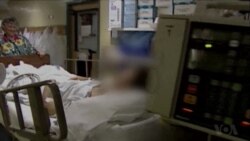ບັນດານັກວິທະຍາສາດແມ່ນກຳລັງສືບສວນສອບສວນ ການປິ່ນປົວຄົນທີ່ເປັນໂຣກມະ ເຮັງຕັບດ້ວຍວິທີໃໝ່. ຂັ້ນຕອນຕ່າງໆແມ່ນນັບຈາກການພັດທະນາຕັບທຽມ, ເພື່ອເບິ່ງວ່າ ໝູທີ່ຖືກດັດແປງພັນທຸກຳ ຈະສາມາດຜະລິດອະໄວຍະວະທີ່ໃຊ້ໄດ້ກັບຄົນຫຼືບໍ່. ນັກຂ່າວວີ ໂອເອ Carol Pearson ມີລາຍງານ ກ່ຽວກັບ ວິທີອີກແນວໃໝ່ທີ່ຖືກນຳໃຊ້ຢູ່ມະຫາວິທະ ຍາໄລລັດ Missouri, ເຊິ່ງ ພຸດທະສອນ ຈະນຳລາຍລະອຽດມາສະເໜີທ່ານ.
ສຳລັບຄົນທີ່ເປັນໂຣກມະເຮັງຕັບ, ວິທີດຽວທີ່ຈະປິ່ນປົວພວກເຂົາເຈົ້າກໍຄືການປ່ຽນຕັບ ຫຼື ຕັດສ່ວນທີ່ເປັນໂຣກມະເຮັງຂອງອະໄວຍາວະນັ້ນອອກ. ທັງສອງຢ່າງນີ້ຕ້ອງໄດ້ທຳການ ຜ່າຕັດຢ່າງໃຫຍ່. ແລະ ຄົນເຈັບຜູ້ທີ່ປ່ຽນອະໄວຍາວະດັ່ງກ່າວຕ້ອງໄດ້ກິນຢາພູມຄຸ້ມກັນ ໂຣກໄປຕະຫຼອດຊີວິດຂອງພວກເຂົາເຈົ້າ.
ແນວໃດກໍຕາມ, ບັນດານັກວິທະຍາສາດກຳລັງເຮັດວຽກ ກ່ຽວກັບ ວິທີໃໝ່ທີ່ເຮັດໃຫ້ໂຣກ ມະເຮັງແຜ່ກະຈາຍໄປໜ້ອຍທີ່ສຸດ. ການບຳບັດທາງເຄມີ ແລະ ສາຍລັງສີ ທັງສອງຢ່າງນີ້ ເຮັດໃຫ້ແຊລເລືອດ ທີ່ແຂງແຮງອ້ອມເນື້ອງອກໄດ້ຮັບຄວາມເສຍຫາຍ. ແຕ່ວິທີນີ້ ລວມມີ ການໃຊ້ສານປະກອບຈາກທຳມະຊາດ ແລະ ບໍ່ເປັນພິດຈາກພືດ.
ທ່ານ Kettesh Katti ສາສະດາຈານທີ່ມະຫາວິທະຍາໄລ ມິສຊູຣີ ພະແນກແພດສາດ, ຜູ້ນຳພາການສຶກສາທີ່ໃຊ້ເທັກໂນໂລຈີຂະໜາດນ້ອຍ ເພື່ອແນເປົ້າ ແລະ ທຳລາຍແຊລ ເນື້ອງອກອ່ອນໃນຕັບຂອງໂຕໜູ ແລະ ແຊລມະນຸດໃນຫຼອດແກ້ວ.
ທ່ານ Katti ກ່າວວ່າ “ຟັງແລ້ວຄືແມ່ນນະວະນິຍາຍແນວໃດແນວໜຶ່ງ, ແຕ່ພວກເຮົາໄດ້ ຢູ່ໃນລະດັບທີ່ກ້າວໜ້າແລ້ວ ໃນເລື່ອງຂອງການປິ່ນປົວເນື້ອງອກ, ໃນເລື່ອງການປິ່ນ ປົວໂຣກມະເຮັງ.”
ວຽກຂອງທ່ານ Katti ປະກອບມີຜົງທີ່ນ້ອຍຫຼາຍຈາກຫຼອດແຄັບຊູລຄຳ ໃນເຄື່ອງກັນສະ ເທືອນຈາກຕົ້ນກະຖິນ ຫຼື Acacia. ຜົງດັ່ງກ່າວຈະດຶງດູດແຊລມະເຮັງອ່ອນ ແລະ ມະເຮັງ ຮ້າຍ, ເຊິ່ງອ່ອນໄຫວຕໍ່ລະດັບຄວາມຮ້ອນທີ່ຕຳກວ່າແຊລທີ່ແຂງແຮງ.
ທ່ານ Katti ກ່າວວ່າ “ຄົນເຈັບຈະໄດ້ຮັບຜົງຂະໜາດນ້ອຍພວກນີ້. ໃນບໍ່ເທົ່າໃດຊົ່ວ ໂມງ, ເຂົາເຈົ້າກໍຈະຖືກປິ່ນປົວດ້ວຍແສງເຣເຊີ, ແລ້ວພວກເຂົາເຈົ້າກໍຈະສາມາດກັບ ບ້ານໄດ້. ດັ່ງນັ້ນ, ມັນຈຶ່ງຈະບໍ່ມີການສາຍແສງລັງສີໃສ່. ບໍ່ມີວັດຖຸທີ່ເປັນອັນຕະລາຍ, ບໍ່ມີພິດຮ້າຍຕໍ່ຄົນໄຂ້.”
ທ່ານ Katti ກ່າວວ່າ ຄ່າຂອງການປິ່ນປົວຈະຖືກກວ່າ ເພາະວ່າຄຳໜຶ່ງກຣາມ ສາມາດປິ່ນ ປົວຄົນໄຂ້ໄດ້ 50 ຄົນ, ແລະ ທ່ານ Katti ກ່າວວ່າ ຍິ່ງໄປກວ່ານັ້ນ ການປິ່ນປົວຊະນິດນີ້ ສາມາດໃຊ້ໄດ້ ກັບໂຣກມະເຮັງຊະນິດອື່ນນຳ, ເຊັ່ນຂໍ້ຕໍ່ອັກເສບ, ໂຣກທີ່ເຮັດໃຫ້ອ່ອນ ເພຍອື່ນໆ. ຂັ້ນຕອນຕໍ່ໄປກໍຈະແມ່ນ ການທົດລອງກັບຄົນໃນໂຮງໝໍ.
ຖ້າເທັກນິກນີ້ໄດ້ຜົນ, ມັນກໍຈະເປັນຂ່າວດີສຳລັບຄົນເກືອບ 8 ແສນຄົນທີ່ກຳລັງປິ່ນປົວ ໂຣກມະເຮັງຕັບຢູ່ໃນແຕ່ລະປີ ແລະ ມັນອາດຈະຊ່ວຍຊີວິດຂອງຄົນໄວ້ໄດ້ປະມານ 7 ແສນຄົນທີ່ເສຍຊີວິດໄປຍ້ອນໂຣກນີ້ໃນແຕ່ລະປີ.
Scientists are investigating new ways of treating people with liver cancer. The methods range from developing an artificial liver, to seeing if genetically-modified pigs could produce organs compatible with humans. VOA's Carol Pearson reports on yet another approach being taken at the University of Missouri.
The only cure for liver cancer lies in a liver transplant or the removal of the cancerous part of the liver. Both methods involve major surgery, and, for patients who get a transplant, a lifetime of immuno-suppressant drugs to prevent their bodies from rejecting the new organ.
But, in the future, there may be another way to treat liver cancer.
A study led by researchers at the University of Missouri School of Medicine has shown that a new, minimally invasive approach can target and destroy precancerous tumor cells in the livers of mice and in in-vitro human cells.
With both chemotherapy and radiation, healthy cells around the tumor are damaged. But this approach involves the use of natural, non-toxic chemical compounds from plants.
"It sounds like a fairy tale, butwe are really in advanced stages in terms of tumor treatment, in terms of disease diagnostics."
Kattesh Katti was the lead author of the study that used very small particles of gold -- nano particles -- encapsulated in a protective stabilizer from an acacia tree. The particles attract precancerous and malignant cells, which are far more susceptible to lower levels of heat than healthy cells.
"The patient will be administered with these nano particles. Within a couple of hours, the patient will be treated with lasers, and then the patient can go home. So, there is no radioactivity, there is no toxic waste, there is no toxicity, systemic toxicity, to the patient."
Katti says the cost of treatment will be low, and what's more, he says this type of treatment could be used for other types of cancer, arthritis and other debilitating diseases.
Should this technique work, it would be good news for the nearly 800,000 people who are diagnosed with liver cancer each year.










